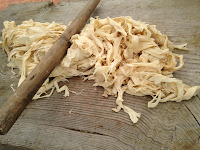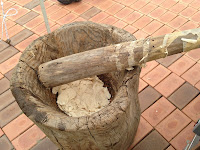 |
| Korean Hanji Paper |
Hanji is one of the treasures of Korea. It is a unique and valuable material that has brought great pride to the Korean people. It has built a strong reputation throughout the centuries, as being one of the most resistant, durable and, oh my, gorgeous papers in the world.
Hanji literally means The Paper of Korea: the word han to "Korea" and the word ji meaning "paper". It is interesting to mention that the word "Hanji" was invented when western paper was introduced to Korea; Korean paper makers wanted to distinguish their unique paper from others. These days, the word "Hanji" refers generally to handmade mulberry paper.
Hanji paper has been a part of Korean life and tradition for over a thousand years; its presence was extremely important in everyday life, as well as special occasions. Hanji is an extremely durable and high-quality paper, made from the inner bark of the mulberry tree, which grows especially well on the Korean peninsula.
Hanji Is Used In Very Many Ways :
- covering for doors and windows of traditional Korean houses;
- covering for doors and windows of Buddhist temples, Royal palaces, and other important buildings;
- calligraphy paper;
- printing paper for important documents and books;
- wall papering;
- household objects: fans, tobacco pouches, notebooks, shrouds, rope and string, baskets, shoes, clothes, umbrellas, etc.
- arts and crafts.
 |
| Mulberry pulp is very resistant, because of the length of its fibers. |
What Is So Special About Hanji?
What does make Hanji so special? How can it be so durable?
The answer is in the bark of the mulberry tree. This bark is so strong that it can be immersed in water for an entire year without decomposing! Also, as the fibers of the bark are wide, it allows both air and light to go through.The mulberry pulp is naturally PH neutral and has an incomparable longevity; the fibers of the mulberry pulp are longer, more flexible and more resistant than other plants'. Its extraordinary resilience makes it a prime choice for archival use; that's why the most important documents in the history of Korea have been written or printed on Hanji paper.
It is also claimed that in old times Hanji was used to make armor! Evidently the toughness of the Hanji paper could stop arrows.
How Hanji Is Made
Traditional Korean Hanji is made with mulberry pulp and clean water, without any fillers or additives.
 |
| The pulp is steamed, then beaten. |
1) Harvesting the mulberry
2) Soaking, peeling and steaming of the mulberry bark
3) Steaming, washing and natural bleaching of the pulp
4) Beating, to disintegrate the fibers and dissolve the starch
5) Forming the wet sheets of paper
6) Drying the sheets
7) Pounding of the dried sheets of paper
Of course, the production of the Hanji paper has followed the natural evolution of technology. Despite the presence of large companies producing Hanji paper abroad, the Korean artisans have kept going with the handmade production of genuine Korean Hanji. In 2009, we could still about two dozens traditional Hanji paper mills in South Korea.
 |
| Traditional Chinese Dragon Design |
There are two major annual festivals celebrating Hanji paper in Korea; there are also some important institutes, schools, museums, cultural and industrial centers dedicated to the promotion and the development of Hanji.
 |
| Hanji Paper Coasters, Traditional Chinese Character "Longevity |
Stay tuned for my next article and learn more about my creative process, or
how a French-Canadian girl literaly fell in love with Korean paper!
If you missed out on Part I of this series, please see here :
The Art Of Hanji Introduction - Korean Crafts Series Part I
If you missed out on Part I of this series, please see here :
The Art Of Hanji Introduction - Korean Crafts Series Part I
PRESENTED TO YOU BY OUR LOVELY LEADER:
My name is Natalie. I am a French-Canadian gal, but I live in South Korea. My passion is called "Hanji" : sumptuous Korean paper made of mulberry pulp. Hanji has been used for a thousand years in Korea to create decorative or ceremonial objects. For me, it is essential to offer useful and practical objects, that can enjoyed on a daily basis. Tissue cases, pen holders, piggy banks, fridge magnets: let the beauty and unique character of Hanji make our everyday life objects irresistible!
www.etsy.com/shop/HanjiNaty
Follow Natalie's Blog For The Latest Updates To Her Shop www.hanjinaty.com |




I love paper. I love learning something new. So I’m really enjoying your well written, well presented series.
ReplyDeletePaper isn’t something I can work with anymore, but, I can feel myself getting pulled in! Eventually I’ll just have to own a piece or two. I’ll think of some way to use it. ;-)
Extremely interesting article and beautiful items! Thank you for sharing!!! :)
ReplyDeleteI love it:))) thanks for sharing with us!!!
ReplyDeleteIldi
Thanks for such an informative article.
ReplyDelete